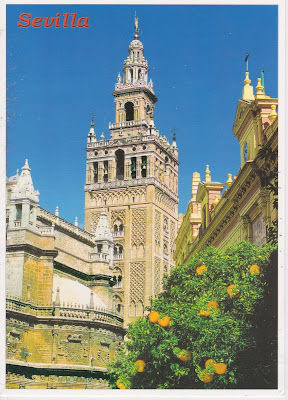The Giralda, Seville, Spain
The postcard this week features a photograph of the bell tower, called the Giralda, of the Seville Cathedral in Seville, Spain. The photographer is not identified but the card does have the number 107 V on the reverse. This card is another of those shared by my son and his wife from their trip to Portugal and Spain earlier this year.
The tower was originally built as the minaret for the Great Mosque of Seville during the reign of the Almohad dynasty in Al-Andalus, Moorish Spain. Catholics added a Renaissance-style top after Muslims left the area. UNESCO designated the Giralda as a World Heritage Site in 1987. The tower is 342 feet or 104.1 meters high and has been one of the prominent symbols of the city since the Middle Ages.
The Mosque was commissioned by caliph Abu Ya-qub Yusuf in 1171 to replace a smaller mosque because the congregation had grown larger than the smaller prayer hall could accommodate. The Mosque was completed in 1176 except for the minaret where construction did not begin until 1184 even though prayers were held there beginning in 1182. The death of both the architect and the caliph stalled the building of the minaret and it was not until 1198 that the tower was completed. That tower had four precious metal spheres of gold or bronze at the peak of the tower. Those were replaced with a cross and bell after building was made into a cathedral by Christians in 1248. The cathedral suffered damage during the 1356 earthquake. A new cathedral was begun in 1433 and completed 73 years later in 1506.
The Giralda has a series of ramps that wind around the perimeter of several vaulted chambers. The ramps were designed to be wide enough and high enough to be used by people, custodians, and beasts of burden. The windows in the tower are decorated to match the ramps and maximize the interior lighting. Some embellishments to the tower were removed during a modern restoration.
The Giralda is an example of Gothic and Baroque architectural styles and is one of the largest churches in the world.
For additional information, see:
https://en.wikipedia.org/wiki/Giralda

No comments:
Post a Comment